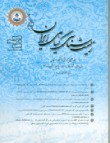The Effect of Some Nanoparticles and Biofertilizers on Chlorophyll Fluorescence Components and Some Physiological Traits of Triticale (Triticosecale Wittmack) at Different Irrigation Levels
Author(s):
Article Type:
Research/Original Article (دارای رتبه معتبر)
Abstract:
In order to investigate the effects of nanoparticles) nano Fe-Si oxide) and biofertilizers (Azospirillum lipoferum and Pseudomonas putida) on chlorophyll fluorescence components and some physiological traits of triticale at different levels of irrigation, an experimental as the factorial study was conducted based on randomized complete block design with three replications. The studied factors included three levels of irrigation (full irrigation as control, irrigation withholding at 50% of booting and heading stages as severe, and moderate water limitation, respectively), application of biofertilizers (Azospirillum lipoferum and Pseudomonas putida) in four levels, and nanoparticles foliar application (nano iron oxide and nano silicon oxide) at four levels. Both applications of plant growth-promoting rhizobacteria and nanoparticle foliar application under full irrigation increased chlorophyll index (50.23%), relative water content (43.97%), stomatal conductance (36.78%), quantum yield (47.38%), maximum fluorescence (34.84%), variable fluorescence (98.49%), and grain yield (43.28%) in comparison to no application of biofertilizers and nanoparticles under irrigation withholding at booting stage. Both applications of plant growth-promoting rhizobacteria and nanoparticles increased the chlorophyll index, relative water content, stomatal conductance, quantum yield, maximum fluorescence, variable fluorescence and grain yield in both levels of full irrigation and severe water limitation, but decreased electrolyte leakage and minimum fluorescence. In addition, severe water limitation or irrigation withholding at the booting stage increased chlorophyll index (7.74%), relative water content (10.99%), stomatal conductance (22.46%), quantum yield (15.2%), maximum fluorescence (26.54%), variable fluorescence (75.61%) and grain yield (28.59%) in comparison to no application of biofertilizers and nanoparticles at the same irrigation level. Generally, the application of biofertilizers and nanoparticles showed a better performance at different irrigation levels due to the improvement of physiological traits.
Introduction
Triticale is a human-made crop, being a hybrid by cross-fertilization of wheat (Triticum spp.) and rye (Secale spp.). In general, triticale combines the high yield potential of wheat with the biotic and abiotic stress tolerance of rye, making it more suitable for production in marginal areas (acidic, saline, or soils with heavy metal toxicity) (Cantale et al. 2016). In arid and semi-arid regions, drought stress as the main factor and salinity stress as a secondary factor decrease plant growth and yield. Water limitation can damage pigments and plastids, and educe chlorophyll index, stomatal conductance, quantum yield, and relative water content. Several strategies have been developed in order to decrease the toxic effects caused by environmental stresses on plant growth. Among them, the use of bio-fertilizers such as plant growth-promoting rhizobacteria (PGPR) and also nanoparticles such as nano iron-silicon oxide plays a very important role in yield improvement. Inoculation of plants with native suitable microorganisms may decrease the deleterious effects of environmental stresses and increase stress resistance of plants by various mechanisms, including synthesis of phytohormones such as auxins, cytokinin and gibberellins, solubilization of minerals like phosphorus, production of siderophores and increase in nutrient uptake. There is little information on the effects of nanoparticles and biofertilizers on chlorophyll fluorescence components and some physiological traits of triticale at different irrigation levels. Therefore, the objective of the present study was to evaluate the effect of nanoparticles (nano Fe-Si oxide) and biofertilizers (Azospirillum lipoferum and Pseudomonas putida) on chlorophyll fluorescence components and some physiological traits of triticale at different levels of irrigation.Materials and Methods
An experiment as factorial was conducted based on a randomized complete block design with three replications at the research farm of the Faculty of Agriculture and Natural Resources, University of Mohaghegh Ardabili in 2021. The experimental factors included irrigation in three levels (full irrigation as control, irrigation withholding at 50% of booting and heading stages as severe, and moderate water limitation, respectively (BBCH 43 and 55 respectively), the application of biofertilizers in four levels (no application as control, application of Azospirillum, Pseudomonas, both application Azospirillum + Pseudomonas) and nanoparticles foliar application at four levels (foliar application with water as control, nano iron oxide foliar application (1 g.L-1), nano silicon oxide (50 mg.L-1), both application nano iron-silicon oxide). Psedomunas and Azospirillum were isolated from the rhizospheres of wheat by the Research Institute of Soil and Water, Tehran, Iran. For inoculation, seeds were coated with gum Arabic as an adhesive and rolled into the suspension of bacteria until uniformly coated. The strains and cell densities of microorganisms used as PGPR in this experiment were 1×108 colony forming units (CFU). In each plot, there were 5 rows with 2 m long. In each experimental plot, two beside rows and 0.5 m from the beginning and end of planting lines were removed as margin, and measurements were done on 0.2 m2 for grain yield. The used nano silicon-iron oxide had an average particle size of less than 30 nm and the special surface of particles was more than 30 m2.g-1. They were the product of Nanomaterial US Research which was provided by Pishgaman Nanomaterials Company of Iran. Nano silicon oxide and nano silicon oxide powder were added to deionized water and placed on ultrasonic equipment (100 W and 40 kHz) on a shaker for better solution. Foliar application of nano silicon and nano iron oxide was done in two stages of period growth BBCH 21 and 30. Chlorophyll Index was calculated by a chlorophyll meter (SPAD-502; Konica Minolta Sensing, Inc., Japan). RWC and EL were measured according to the method of Kostopoulou et al. (2010) and Farooq and Azam (2006), respectively. Quantum yield was measured on flag leaves by the uppermost fool expanded leaf using a fluorometer (chlorophyll fluorometer; Optic Science-OS-30 U.S.A.). Analysis of variance and mean comparisons were performed using software package SAS v9.12. The main effects and interactions were compared by LSD (least significant difference) test at the 0.05 probability level, using the SAS version 9.1. Results and Discussion
The results showed that both applications of plant growth-promoting rhizobacteria and nanoparticle foliar application under full irrigation increased chlorophyll index (50.23%), relative water content (43.97%), stomatal conductance (36.78%), quantum yield (47.38%), maximum fluorescence (34.84%), variable fluorescence (98.49%), and grain yield (43.28%) in comparison to no application of biofertilizers and nanoparticles under irrigation withholding at booting stage. Both applications of plant growth-promoting rhizobacteria and nanoparticles increased chlorophyll index, relative water content, stomatal conductance, quantum yield, maximum fluorescence, variable fluorescence, and grain yield at both levels of full irrigation and severe water limitation, but decreased electrolyte leakage and minimum fluorescence. In addition, severe water limitation or irrigation withholding at the booting stage increased chlorophyll index (7.74%), relative water content (10.99%), stomatal conductance (22.46%), quantum yield (15.2%), maximum fluorescence (26.54%), variable fluorescence (75.61%), and grain yield (28.59%) in comparison to no application of biofertilizers and nanoparticles at the same level from irrigation levels.Conclusion
Based on the results of the study, the application of biofertilizers and nanoparticles showed a better performance at different irrigation levels due to the improvement of physiological traits. In other words, the effects of the simultaneous application of PGPR and nanoparticle inoculation are more positive than the single application of PGPB and nanoparticles. Therefore, one of the suitable methods to improve plants' resistance to environmental stress is the application of PGPB and nanoparticles, which play a very important role in yield and growth improvement.Keywords:
Language:
Persian
Published:
Iranian Journal of Plant Biology, Volume:14 Issue: 3, 2023
Pages:
13 to 40
magiran.com/p2635867
دانلود و مطالعه متن این مقاله با یکی از روشهای زیر امکان پذیر است:
اشتراک شخصی
با عضویت و پرداخت آنلاین حق اشتراک یکساله به مبلغ 1,390,000ريال میتوانید 70 عنوان مطلب دانلود کنید!
اشتراک سازمانی
به کتابخانه دانشگاه یا محل کار خود پیشنهاد کنید تا اشتراک سازمانی این پایگاه را برای دسترسی نامحدود همه کاربران به متن مطالب تهیه نمایند!
توجه!
- حق عضویت دریافتی صرف حمایت از نشریات عضو و نگهداری، تکمیل و توسعه مگیران میشود.
- پرداخت حق اشتراک و دانلود مقالات اجازه بازنشر آن در سایر رسانههای چاپی و دیجیتال را به کاربر نمیدهد.
In order to view content subscription is required
Personal subscription
Subscribe magiran.com for 70 € euros via PayPal and download 70 articles during a year.
Organization subscription
Please contact us to subscribe your university or library for unlimited access!



